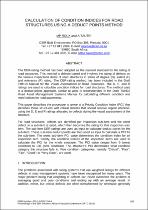 ResearchSpace
ResearchSpace
Calculation of condition indices for road structures using a deduct points method
JavaScript is disabled for your browser. Some features of this site may not work without it.
- ResearchSpace
- →
- Research Publications/Outputs
- →
- Conference Publications
- →
- View Item
| dc.contributor.author |
Roux, Michael P

|
|
| dc.contributor.author |
Taute, A

|
|
| dc.date.accessioned | 2016-11-29T10:02:03Z | |
| dc.date.available | 2016-11-29T10:02:03Z | |
| dc.date.issued | 2016-07 | |
| dc.identifier.citation | Roux, M.P. and Taute, A. 2016. Calculation of condition indices for road structures using a deduct points method. In: South African Transport Conference, 4-7 July 2016, Pretoria, South Africa | en_US |
| dc.identifier.uri | http://hdl.handle.net/10204/8871 | |
| dc.description | South African Transport Conference, 4-7 July 2016, Pretoria, South Africa | en_US |
| dc.description.abstract | The DER-rating method has been adopted as the national standard for the rating of road structures. This method is defects-based and involves the rating of defects on the various inspections items of road structures in terms of degree (D), extent (E) and relevancy (R) rating. The DER-rating method has been included in the Draft TMH19 Manual for the Visual Assessment of Road Structures. The D, E, and R ratings are used to calculate condition indices for road structures. The method used is a deduct-points approach, similar to what is recommended in the Draft TMH22 Road Asset Management Systems Manual for calculating different condition and need indices for road pavements. This paper describes the procedure to arrive at a Priority Condition Index (PCI) that identifies those structures with critical defects that should receive urgent attention, using the D, E and R ratings allocated to defects during the visual assessment of the structure. For road structures, defects are identified per inspection sub-item and the worst defect on a sub-item is rated, which then becomes the rating for that inspection sub-item. The sub-item DER ratings are used as input to calculate deduct points for the sub-item. These sub-item deduct points are then used as input to calculate a PCI for the sub-item. The worst sub-item PCI value determines the condition index for an inspection item. Finally, the condition indices of the inspection items are used to calculate the PCI for the whole structure. The PCI value ranges from 0 (worst condition) to 100 (best condition). The structure’s PCI determines what condition category the structure falls in. Five condition categories, namely ”Critical”; “Poor”, “Fair”, “Good”; or “Very Good”, are used. | en_US |
| dc.language.iso | en | en_US |
| dc.publisher | SATC | en_US |
| dc.relation.ispartofseries | Workflow;17356 | |
| dc.subject | Road structure conditions | en_US |
| dc.subject | DER-rating method | en_US |
| dc.subject | Road Asset Management Systems Manual | en_US |
| dc.subject | Priority Condition Index | en_US |
| dc.subject | DER-rating | en_US |
| dc.title | Calculation of condition indices for road structures using a deduct points method | en_US |
| dc.type | Conference Presentation | en_US |
| dc.identifier.apacitation | Roux, M. P., & Taute, A. (2016). Calculation of condition indices for road structures using a deduct points method. SATC. http://hdl.handle.net/10204/8871 | en_ZA |
| dc.identifier.chicagocitation | Roux, Michael P, and A Taute. "Calculation of condition indices for road structures using a deduct points method." (2016): http://hdl.handle.net/10204/8871 | en_ZA |
| dc.identifier.vancouvercitation | Roux MP, Taute A, Calculation of condition indices for road structures using a deduct points method; SATC; 2016. http://hdl.handle.net/10204/8871 . | en_ZA |
| dc.identifier.ris | TY - Conference Presentation AU - Roux, Michael P AU - Taute, A AB - The DER-rating method has been adopted as the national standard for the rating of road structures. This method is defects-based and involves the rating of defects on the various inspections items of road structures in terms of degree (D), extent (E) and relevancy (R) rating. The DER-rating method has been included in the Draft TMH19 Manual for the Visual Assessment of Road Structures. The D, E, and R ratings are used to calculate condition indices for road structures. The method used is a deduct-points approach, similar to what is recommended in the Draft TMH22 Road Asset Management Systems Manual for calculating different condition and need indices for road pavements. This paper describes the procedure to arrive at a Priority Condition Index (PCI) that identifies those structures with critical defects that should receive urgent attention, using the D, E and R ratings allocated to defects during the visual assessment of the structure. For road structures, defects are identified per inspection sub-item and the worst defect on a sub-item is rated, which then becomes the rating for that inspection sub-item. The sub-item DER ratings are used as input to calculate deduct points for the sub-item. These sub-item deduct points are then used as input to calculate a PCI for the sub-item. The worst sub-item PCI value determines the condition index for an inspection item. Finally, the condition indices of the inspection items are used to calculate the PCI for the whole structure. The PCI value ranges from 0 (worst condition) to 100 (best condition). The structure’s PCI determines what condition category the structure falls in. Five condition categories, namely ”Critical”; “Poor”, “Fair”, “Good”; or “Very Good”, are used. DA - 2016-07 DB - ResearchSpace DP - CSIR KW - Road structure conditions KW - DER-rating method KW - Road Asset Management Systems Manual KW - Priority Condition Index KW - DER-rating LK - https://researchspace.csir.co.za PY - 2016 T1 - Calculation of condition indices for road structures using a deduct points method TI - Calculation of condition indices for road structures using a deduct points method UR - http://hdl.handle.net/10204/8871 ER - | en_ZA |





